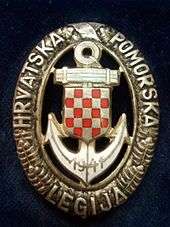Croatian Naval Legion

The Croatian Naval Legion (Croatian: Hrvatska pomorska legija) was a contingent of volunteers from the Independent State of Croatia that served with the German Navy (Kriegsmarine) on the Black Sea and Adriatic Sea during World War II.
The Legion was formed in July 1941, following the German invasion of the Soviet Union on 22 June. It was initially comprised some 350 officers and ratings in German uniform, but this eventually swelled to 900–1,000. Their first commander was Commander Andro Vrkljan, who was commissioned as a Fregattenkapitän (frigate captain) in the German Navy.[1] Vrkljan was later replaced by Captain Stjepan Rumenović.[2] The Croats' purpose in posting a naval contingent to the Black Sea was to evade the prohibition on an Adriatic navy imposed by the Treaty of Rome (18 May 1941) with Italy. This prohibition effectively limited the Croatian Navy (RMNDH) to a riverine flotilla.[3]
The Croatian Naval Legion arrived at Varna in Bulgaria on 17 July 1941. It trained on minesweepers and submarines. On 39 September it was moved to Geniscek in the Ukraine, where it was activated as the 23rd Minesweeper Flotilla (23. Minensuchflottille).[4] The unit did not have any ships upon its arrival in the Sea of Azov.[3] It managed to scrounge up 47 damaged or abandoned fishing vessels, mostly sailing ships, and to man them with hired local Russian and Ukrainian sailors, many of them deserters from the Soviet Navy.[5] Over the winter of 1941–42, the legionnaires dug trenches and fought as infantry in defence of the town. They only put to sea in April 1942.[4]
The Legion patrolled a coastal sector of the Sea of Azov. On 24 September 1942, the Poglavnik Ante Pavelić visited the naval headquarters, where he reached an agreement with the Germans to train and equip a "submarine fighter flotilla" (Unterseebootsjagdflottille) that would undertake anti-submarine patrols.[5] At the end of 1942 the Legion returned to Croatia to recuperate, and in the new year returned to Varna.[4] In 1943, the Legion was expanded by a single battery of coastal artillery.[1]
With the capitulation of Italy (September 1943), there was no longer any impediment to a Croatian navy on the Adriatic Sea. The Croatian Naval Legion returned to Zagreb on 21 May 1944.[6] It was then posted to Trieste, where it operated as a Schnellboot flotilla under the 11th Security Division (11. Sicherungsdivision). It was disbanded in December 1944 to prevent defections,[2] and its crews were incorporated into the RMNDH.[1]
Notes
- 1 2 3 Williamson 2001, pp. 9–10.
- 1 2 Thomas & Mikulan 1995, p. 18.
- 1 2 Müller 2012, p. 98.
- 1 2 3 Bishop 2005, p. 102.
- 1 2 Müller 2012, p. 100.
- ↑ Broucek 1988, p. 156 n. 21.
References
- Bishop, Chris (2005). Hitler's Foreign Divisions: Foreign Volunteers in the Waffen SS, 1941–45. Spellmount. ISBN 978-1-86227-289-7.
- Broucek, Peter (1988). Ein General im Zwielicht: die Erinnerungen Edmund Glaises von Horstenau. Böhlau. ISBN 3-205-08749-6.
- Müller, Rolf-Dieter (2012). The Unknown Eastern Front: The Wehrmacht and Hitler's Foreign Soldiers. I. B. Tauris. ISBN 978-1-78076-890-8.
- Thomas, Nigel; Mikulan, Krunoslav (1995). Axis Forces in Yugoslavia, 1941–45. Osprey Publishing. ISBN 978-1-85532-473-2.
- Williamson, Gordon (2001). German Seaman, 1939–45. Osprey Publishing. ISBN 1-84176-327-6.
External links
- Allen Milcic (2012), Croatian Naval Legion at Axis History.